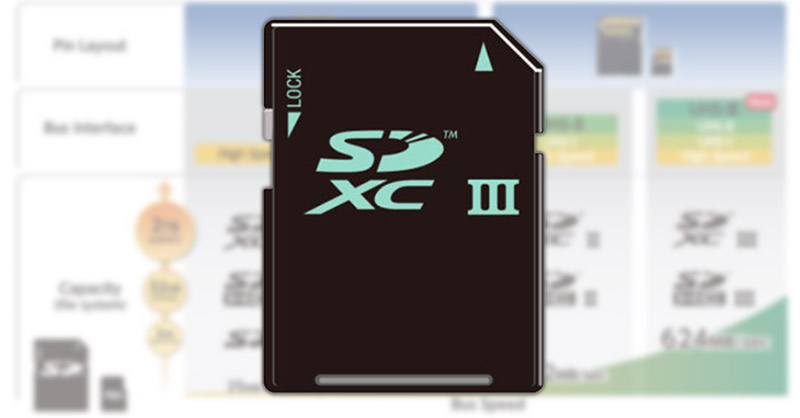

The SD Card association (SDA) has released the SD 6.0 specification which adds a new level of UHS-III bus interface, providing up to 624 MB/sec transfer rates. This update to the Ultra High Speed standard directly answers the demand for 8K, 360-degree and 5G IEEE802.11ax mobile network support. The upgrade is fully backwards compatible and includes all the functionalities of the UHS-II standard with the addition of 3.12/6.24 Gpbs FD modes and Quick Recovery function.
There are four available bitrate segments in UHS-III, the first two Range A and B were introduced with UHS-II, having an RCLK frequency of 26-52MHz. By 8b/10b coding and half-duplex mode, setting D0 and D1 lanes to the same direction for data rate enhancement yields maximum transmission speeds for Range A and B of 156MB/s and 312MB/s, respectively. The two other Range C and D added in UHS-III has an RCLK frequency of 48-52MHz and by 8b/10b coding and full-duplex mode (bus direction switch is not needed), it can reach transmission rates of 312MB/s and 624MB/s, respectively. A UHS-III card must support all ranges from A through D. SD memory cards have been progressing in two aspects: greater storage capacity and faster bus speed. As SDA propels higher storage capacity and faster bus speed specifications, it enables applications to manage big data with an SD memory card.
| Range | RCLK Frequency | Available Bitrate/Lane | Max Transmission Speed | Note |
| Range A | 26 – 52 MHz | 0.39 – 0.78 Gbps | 156 MB/s (Half-Duplex) | Available in UHS-II/III |
| Range B | 26 – 52 MHz | 0.78 – 1.56 Gbps | 312 MB/s (Half-Duplex) | Available in UHS-II/III |
| Range C | 48 – 52 MHz | 2.88 – 3.12 Gbps | 312 MB/s (Full-duplex) | Available in UHS-III |
| Range D | 48 – 52 MHz | 5.76 – 6.24 Gbps | 624 MB/s (Full-duplex) | Available in UHS-III |
NVIDIA® GeForce RTX™ 40 Series GPUs are beyond fast for gamers and creators. They're powered…
Step into the Republic with the ASUS ROG STRIX X870-F GAMING WIFI, where the power…
NVIDIA® GeForce RTX™ 40 Series GPUs are beyond fast for gamers and creators. They're powered…
The MSI MAG X870E TOMAHAWK WIFI is a high-performance ATX motherboard designed for AMD Ryzen…
The MSI B860 GAMING PLUS WIFI motherboard represents the pinnacle of gaming technology, meticulously engineered…
The MONTECH TITAN GOLD series provide premium components and ultra-quiet high performance to all level…